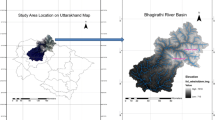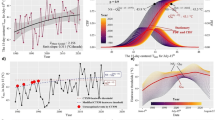Abstract
Change point detection is an effective tool to identity whether the hydrological data are of consistency. In this paper, Pettitt test was first used to detect change point for annual rainfall and runoff time series in 6 selected sub-watersheds of Luanhe river basin in Northeast part of China. Then we presented a method to detect change point according to the law of mutual change of quality and quantity in variable fuzzy sets. We chose the mean of time series as assessment index as in other change point detection methods, and defined 95 and 5 % quantiles of the time series as the supremum and infimum respectively. We selected a reference period (for example, the first 10 points of the time series) as the stationary period, and after the reference period, we checked the mean value of the time series point by point. We used this method in the 6 sub-watersheds of Luanhe river basin. The results of the 2 methods showed that most annual rainfall time series had no change point, and some annual runoff time series had change point in 1979 or 1981. Comparison of the 2 methods was made, and it indicated that Pettitt test provided reference for variable fuzzy sets method, but the latter provided more reasonable results than Pettitt test in this study. This method can also be used in other natural time series.








Similar content being viewed by others
References
Alila Y, Mtiraoui A (2002) Implications of heterogeneous flood‐frequency distributions on traditional stream‐discharge prediction techniques. Hydrol Process 16:1065–1084
Ashagrie AG, de Laat PJ, de Wit MJ et al (2006) Detecting the influence of land use changes on discharges and floods in the Meuse River Basin – the predictive power of a 90-year rainfall-runoff relation? Hydrol Earth Syst Sci 10:691–701
Brown MB, Forsythe AB (1974) Robust tests for the equality of variances. J Am Stat Assoc 69:364–367
Chen SY (2002) Fuzzy recognition theory and application for complex water resources system optimization. Jinlin University Press, Changchun
Chen SY (2012a) Variable sets-the development of variable fuzzy sets and the application in assessment of water resource. Math Pract Theory 42:92–101
Chen S Y. 2012. Variable sets and he theorem and method of optimal decision making for water resource system. 43, 1066–1074.
Chen SY, Guo Y (2006) Variable fuzzy sets and its application in comprehensive risk evaluation for flood-control engineering system. Fuzzy Optim Decis Making 5:153–162
De Roo A (2001) Assessing the effects of land use changes on floods in the meuse and oder catchment. Phys Chem Earth 26:593–599
Farahani MA, Khalili D (2013) Seasonality characteristics and spatio-temperal trends of 7-day low flows in a large, semi-arid watershed. Water Resour Manag 27:4897–4911
Fealy R, Sweeney J (2005) Detection of a possible change point in atmospheric variability in the North Atlantic and its effect on Scandinavian glacier mass balance. Int J Climatol 25:1819–1833
Fraedrich K, Jiang J, Gerstengarbe FW et al (1997) Multiscale detection of abrupt climate changes: application to River Nile flood levels. Int J Climatol 17:1301–1315
Gan TY (1998) Hydroclimatic trends and possible climatic warming in the Canadian Prairies. Water Resour Res 34:3009–3015
Goyal MK (2014) Staticstical analysis of long term trends of rainfall during 1901–2002 at Assam, India. Water Resour Manag 28:1501–1515
Hurst HE, Black RP, Simaika YM. 1965. Long-term storage: an experimental study. Constable, London
Kendall MG (1975) Rank Correlation Methods. Griffin, London, UK
Kundzewicz ZW (2004) Change detection in hydrologogical records-a review of the methodology. Hydrol Sci 49:7–19
Kysel J, Domonkos P (2006) Recent increase in persistence of atmospheric circulation over Europe: comparison with long-term variations since 1881. Int J Climatol 26:461–483
Lee AFS, Heghinian SM (1977) A shift of the mean level in a sequence of independent normal random variables—a Bayesian approach. Technometrics 19:503–506
Li JZ, Feng P (2007) Runoff variations in the Luanhe river basin during 1956–2002. J Geogr Sci 17:339–350
Li D, Xie H, Xiong L (2014) Temporal change analysis based on data characteristics and nonparametric test. Water Resour Manag 28(1):227–240
Mann HB (1945) Nonparametric tests against trend. Econometrica 13:245–259
Meddi MM, Assani AA, Meddi H (2010) Temporal variability of annual rainfall in the Macta and Tafna catchments, Northwestern Algeria. Water Resour Manag 24:3817–3833
Pettit AN (1979) A non-parametric approach to the change-point problem. Appl Stat 28:126–135
Reeves J, Chen J, Wang XL et al (2007) A review and comparison of change point detection techniques for climate data. J Appl Meteorol Climatol 46:900–915
Saghafian B, Farazjoo H, Bozorgy B et al (2008) Flood Intensification due to Changes in Land Use. Water Resour Manag 22:1051–1067
Singh KP (1987) A versatile flood frequency methodology. Water Int 12:139–145
Singh KP, Sinclair RA (1972) Two-distribution method for flood frequency analysis. J Hydraul Div 98:28–44
Singh KP, Wang SX, Zhang L (2005) Frequency analysis of nonidentically distributed hydrologic flood data. J Hydrol 307:175–195
Strupczewski W, Singh V, Feluch W (2001a) Non-stationary approach to at-site flood frequency modelling I. Maximum likelihood estimation. J Hydrol 248:123–142
Strupczewski W, Singh V, Mitosek H (2001b) Non-stationary approach to at-site flood frequency modelling. III. Flood analysis of Polish rivers. J Hydrol 248:152–167
Tabari H, Marofi S (2011) Changes of pan evaporation in the west of Iran. Water Resour Manag 25:97–111
Vogel RM, Yaindl C, Walter M (2011) Nonstationarity: flood magnification and recurrence reduction factors in the United States. J Am Water Resour Assoc 47:464–474
Xie P, Chen GC, Lei HF et al (2010) Hydrological alteration diagnosis system. J Hydroelectric Eng 1:85–91
Xiong L, Guo S (2004) Trend test and change-point detection for the annual discharge series of the Yangtze River at the Yichang hydrological station. Hydrol Sci J 49:99–112
Yue S, Pilon P, Cavadias G (2002) Power of the Mann–Kendall and Spearman’s rho tests for detecting monotonic trends in hydrological series. J Hydrol 259:254–271
Zeng H, Feng P, Li X (2014) Reservoir flood routing considering the Non-stationarity of flood series in north china. Water Resour Manag. doi:10.1007/s11269-014-0744-6
Zhang Z, Dehoff AD, Pody RD et al (2010) Detection of Streamflow change in the Susquehanna river basin. Water Resour Manag 24:1947–1964
Acknowledgments
This work was supported by National Natural Science Foundation (No. 51209157). Authors thank anonymous reviewers for their constructive and helpful feedback on the manuscript.
Author information
Authors and Affiliations
Corresponding author
Rights and permissions
About this article
Cite this article
Li, J., Tan, S., Wei, Z. et al. A New Method of Change Point Detection Using Variable Fuzzy Sets Under Environmental Change. Water Resour Manage 28, 5125–5138 (2014). https://doi.org/10.1007/s11269-014-0798-5
Received:
Accepted:
Published:
Issue Date:
DOI: https://doi.org/10.1007/s11269-014-0798-5




